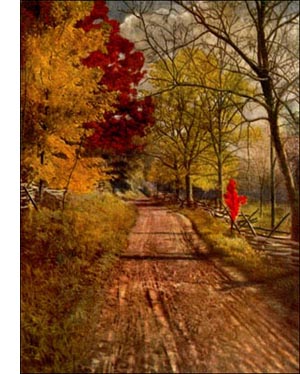Black Alder Tree
 The Black Alder (Alnus glutinosa, Gaertn.), native of Europe, Asia and North Africa, is the most picturesque of water-loving trees, with its dark green, round or oblong leaves glutinous when they unfold in the spring. The trees are tall and erect, with dark trunks. The tallest sometimes reach 70 feet and have a trunk diameter of 3 feet. These giant alders are dignified, indeed, but the rank and file of the species are smaller trees. They hang out their long yellow catkin fringe on the bare twigs in earliest spring, a sight to repay a visit, even if it involved the wearing of rubber boots; and the little green knobs on the branching side stems grow by autumn into ripe cones, out of whose slits fall the little flat seeds.
The Black Alder (Alnus glutinosa, Gaertn.), native of Europe, Asia and North Africa, is the most picturesque of water-loving trees, with its dark green, round or oblong leaves glutinous when they unfold in the spring. The trees are tall and erect, with dark trunks. The tallest sometimes reach 70 feet and have a trunk diameter of 3 feet. These giant alders are dignified, indeed, but the rank and file of the species are smaller trees. They hang out their long yellow catkin fringe on the bare twigs in earliest spring, a sight to repay a visit, even if it involved the wearing of rubber boots; and the little green knobs on the branching side stems grow by autumn into ripe cones, out of whose slits fall the little flat seeds.Compared with oak and ash timber, alder is indifferent in quality and does not interest the lumberman, but there are special uses to which alder is always put. Growing in water, it seems to recognise its element; alder piles, water pipes, pumps and watering troughs kept always saturated last indefinitely. The piles of the Rialto in Venice and those of Amsterdam, according to ancient authorities, are of alder. Exposed to conditions of alternate wet and dry, the wood soon rots. It was a canny Scot who buried alder boards in a peat bog, in which lime was also thrown. This prevented the invasion of destructive insects, and turned the pinkish brown wood to the colour and hardness of mahogany. The grain of alder is smooth, fine and lustrous. It does not warp nor splinter. In the old days it was a wood for the boatbuilder. "Excepting Noah's Ark, the first vessels we read of were made of alder." Virgil gives a pretty glimpse of northern Italy in one of his Georgics:
"And down the rapid Po light alders glide."
Alder wood serves many cheap and common uses: for sabots and clogs, and wooden heels; truncheons, kneading troughs, barrel staves, bobbins, trays, hop poles, and the like. The bark and cones yield tannin used in tanning leather and in medicine, and a yellow dye which is also used in the making of ink. The best charcoal for gunpowder is made from willow and alder. Warty excrescences on old trees and twisted roots furnish the inlayer with small but beautifully veined and very hard pieces. Articles made of this once brought high prices.
One of the best uses to which alder is put is planting in hedges along borders of streams where their roots, closely interlacing, hold the banks against crumbling.
The black alder is most often met in horticultural forms in America. There is a variety with large, shining leaves and red veins and petioles. The daintiest varieties are those with finely cut leaves, of which imperialis, with fingered leaves like the white oak, is a good example.